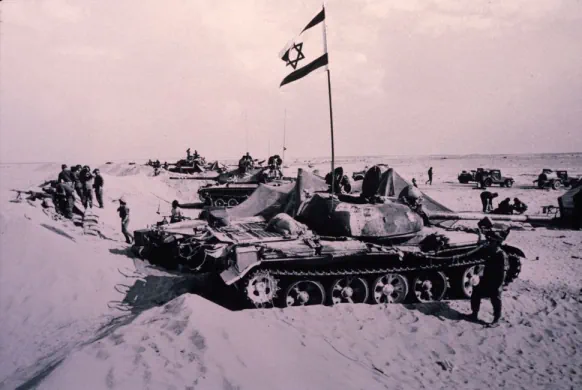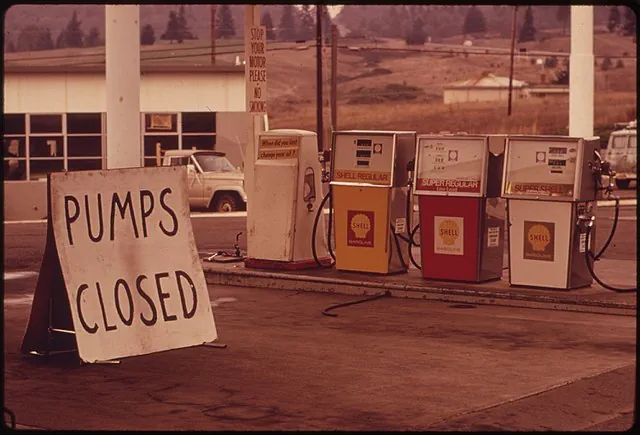

Table of Contents
In October 1973 a fourth Arab-Israeli war was fought, better known as the Yom Kippur War. It was a coordinated attempt of Egypt and Syria to regain what was lost to Israel in the so-called Six-Day War of 1967, but the Israelis once again proved dominant on the battlefield. However, unlike previous confrontations, during this clash, the Arab states finally employed their probably most far-reaching asset – “the oil weapon”, shocking the entire world more than anyone previously expected.
From an idea to a palpable strategy
Initial Arab attempts to use oil as pressure
The basic principle behind using oil as means of pressure wasn’t anything new. Various forms of embargos, blockades, and trade restrictions were used for centuries, for several different vital resources. As oil became one of the most important sources of energy in the early 20th century, sanctions on oil trade became a valid diplomatic and economic form of pressure. An example of such policies can be seen in the US oil embargo on Japan, which in turn caused the Pearl Harbor attack and subsequent entry of the US in the Second World War. Thus, it is not surprising the Arab nations, who represent a sizable number of the world’s petroleum-producing countries, adopted a similar idea of using their oil as a way to enforce their demands.
Their first attempt at utilizing such techniques can be traced to the first Arab-Israeli War and the formation of Israel in 1948. Some members of the Arab League advocated for an oil embargo, but apart from Iraq, no other Arab nation was serious about implementing that policy. Therefore, the first oil embargo was a complete failure, especially as most European economies still relied more on coal than oil. The second attempt came in 1956 and the Suez Canal Crisis, in which Israel also participated. By then, western economies were much more reliant on oil, while more Arab states decided to participate. However, the US ramped up its oil production and saved European economies from any major crisis caused by some 6 months of the Arab embargo. Furthermore, Arab participation was individual, without any kind of significant cooperation and planning.

A Saudi oil refinery in the 1950s. Source:
An important step was made in 1960 when the Organization of the Petroleum Exporting Countries (OPEC) was formed, with the majority of its members being Arab nations. The main goal of this organization is to retake control of the oil market from western corporations and return it to the producing states, increasing their revenue and control of the petroleum industry by coordinating the national policies of its members.
Perfecting the weapon
Forming of OPEC proved vital as it enabled the Arab nations to cooperate better than before, giving them a proper platform to rely on. However, that organization was never meant to be a tool of Arab nationalism. Two of its founding members, Venezuela and Iran, weren’t Arab states, while some other joined later. This dissonance was proven in 1967, during the third Arab-Israeli clash known as the Six-Day War. At the time, the Arab nations once again called up for a boycott of oil, now aimed against the US alongside Western Europe. It lasted for roughly 3 months, once again failing. The partial reason was that Iran and Venezuela ignored the embargo, even increasing their production. Additionally, the US was able to largely satisfy its own demands, while other states increased their reserves from the 1950s and invested in nuclear energy to mitigate oil dependency.
As a result, in early 1968 the Arab nations decided to create their own coordinating body, the Organization of the Arab Petroleum Exporting Countries (OAPEC). Its membership quickly opened up even to non-oil-producing Arab countries, making it more of a political organization than an economic one. Its members were Saudi Arabia, as a de facto leader, Libya, Kuwait, Iraq, Egypt, Syria, Qatar, Dubai, Bahrain, Abu Dhabi, and Algeria. Though it was stipulated that OAPEC resolutions and decisions weren’t going to collide with OPEC policies, these nations began aligning their plans and strategies to use oil to pressure the west to loosen its ties and support to Israel. With that, the Arab nations finally managed to refine the use of the so-called oil weapon, while the overall world dependency on petroleum worked in their favor.
Deploying the oil arsenal
From threats to embargo
By the early 1970s, several OAPEC members began voicing their concerns with the western support to Israel, exerting pressure on Saudi Arabia to act. It was seen as not only a leader of the organization but as of the entire Arab world. Thus, by early 1973 as the least radical members of OAPEC, the Saudis began sending friendly signals to the US that there was a growing resentment amongst the Arab nations, one that could jeopardize oil production and export from the Middle East. However, Washington ignored the warnings, calculating that the petroleum producers would be hurt as much if not more than the west, making any embargoes unlikely. In response, in the late summer of the year, OAPEC members gathered and discussed the use of Arab oil in the service of the Arab cause. Furthermore, in a bilateral meeting, Saudi Arabia also promised Egypt support in case of a renewed war, something that Cairo was already planning.

The Israeli army during the Yom Kippur War. Source
As the US ignored the vague pleads and threats coming from the Arabs, Syria and Egypt commenced their surprise attack on Israel on October 6th, 1973. Other OAPEC members quickly gathered in Kuwait to determine how to proceed. It was clear they would extend support to Egypt and Syria, but the question was how far would they dare to go. There were many worries among the members, from financial losses to the western response. By October 17th the Arab petrol producers agreed to lower their production by 5%, with a further 5% every month as long as the Arab lands occupied by Israel were freed and the issue of Palestinian people resolved. Then a few days later the US went on to give 2.2$ billion to Israel as military aid. In response, Saudi Arabia and most other OAPEC members imposed a full embargo on oil export to the US.
Exact measures
Soon afterward, OAPEC countries reconvened, trying to further elaborate their stance and use of the oil weapon. It was agreed that overall production cutbacks should be 25% (later lowered to 15%), as those percentages encompassed both the original 5% and the production of oil that would have been exported to the US. Furthermore, OAPEC divided the countries of the world into three major categories. First was the most favored, encompassing most Arab and Islamic nations, African countries that severed ties with Israel, as well as Spain France, and England. That group was to retain its pre-October shipments of oil. The second group were the neutral nations, covering the majority of other world nations, who received the available oil after the cutbacks were applied. Finally, there were hostile nations, who in some way assisted Israel. Those were under full embargo and consisted of just five states – the US, the Netherlands, Portugal, South Africa, and Rhodesia.
Immediate consequences and responses
The world, most notably the US, was shocked by the embargo. Some were quick to dismiss it as pure blackmail, even questioning its legality. Others, like France and Britain, deemed it was well within the countries’ rights to choose with whom they trade. Regardless of feelings and attitudes, the oil weapon was quickly felt across the world. Prices of crude oil in December 1973 was almost 4 times higher than it was in October, causing a ripple effect in the economy. Petroleum shortages also caused quite an effect on various industries as well as in agriculture. The economic shock was coupled with the already shaken stock market, causing an even wider financial crisis.

A US fuel pump closed due to oil embargo in 1973
Many affected nations tried to adjust and lessen the issues. Among the most heavily affected was Japan, which had a highly oil-dependent economy with most of its oil coming from the Arab states. It tried to negotiate with the OAPEC, offering to change its stance towards the Arab-Israeli issue as well as some technological and monetary aid, causing the Arabs to lessen their restriction towards Tokyo. Japan, like many other states, also began searching for oil alternatives as well as further increasing its stockpiles. The US, despite having its oil production and importing only about 12% of their petroleum from the Arabs initiated various oil conservation and rationing policies. Due to its previous economic and political instabilities, it was unable to fully cover the loss in oil imports. Poorer nations were also heavily affected, as higher oil prices putting additional strain on already weak economies. For example, India was left in financial and political turmoil after being affected by the oil weapon.
Efficiency and effects of the Arab strategy
Effectiveness of the petroleum embargo
Over the last several decades, scholars and analysts argued if there were any palpable results of Arab pressure through oil. A more conservative view advocates the utter inefficiency of the oil weapon. First of all, the Yom Kippur War ended on October 25th with an Israeli victory. An effective embargo came only by early November, arriving too late to help Egypt and Syria. Nevertheless, OAPEC continued to exert pressure. Yet, even so, many argue that the imposed sanctions didn’t change world opinion towards the Arab-Israeli conflict. For example, Japan’s supposed reorientation towards the Arab cause can be traced even before 1973, while France and Britain were already advocating for Israel to return to pre-1967 borders. Thus, political effectiveness was either quite low or none, at least from that viewpoint.
However, a more progressive view states that the embargo was quite successful if the final goal is adjusted. By deploying the oil weapon, OAPEC did increase awareness towards the Arab-Israeli issue. Furthermore, it managed to persuade some of the states and even more importantly broader public opinion towards their cause. At least, some no longer perceived Israelis as mere victims of the conflict, especially in regards to Palestinian people. The most vivid example is the Netherlands which together with the rest of western Europe began to withdraw from unilateral support to Israel towards a more neutral stance. In the end, the oil weapon didn’t secure Arab victory, but it at least leveled the playing field, at least in the diplomatic arena.
Long-term ramifications of the oil weapon
The petroleum embargo stopped expanding by early 1974, with various negotiations and talks aimed at ending it. Finally, by mid-March 1974, OAPEC lifted its last sanction and officially sheeting its weapon. The petroleum was to flow freely once again, bringing direct Arab pressure to an end. However, this didn’t mean the effects of the oil embargo were to go away quickly, as it left long-term consequences on the economy and diplomacy.
In terms of the economy, oil prices dropped for a while after the embargo was lifted, but never fell back to 1973 levels. This forced many industries to search for less oil-dependent production processes as well as in terms of overall energy production. It also rekindled interest in the development of various types of biofuels. Finally, it transformed the automotive industry, refocusing the interest from luxury cars to more economical types as gas prices were higher than before. Nevertheless, the 1973 oil crisis didn’t fully remove the oil dependency of modern economies.

A graph showing the oil price (relative and nominal) throughout history
In terms of diplomacy, it played a substantial role in the Cold War. On one side, it bolstered the Soviet economy as it increased its petroleum exports. However, it was a short-term remedy for a failing economy. On the other side, it showed some serious cracks in the US dominance over the capitalist block. Both Japan and Western Europe pretty much ignored American policies, taking their stances according to their needs. Nevertheless, their relations were never seriously strained. Finally, these actions gave confidence to the so-called third-world nations, showing them that economic relations worked as a two-way street. Many tried to renegotiate previous arrangements, while the Non-Aligned nations through Group 77 pushed for the establishment of New International Economic Order, a set of UN proposals to end economic colonialism and dependency through a new interdependent economy.
Finally, the use of oil weapon also busted Arab pride and self-esteem, allowing them to seek a more respected position in the world. They also went on to use petroleum for political pressure on several other occasions, leading to several other oil crises. However, it also led to great turmoil in OPEC, as non-Arab states weren’t supportive of their unanimous actions, while other nations became cautious about joining. Thus, overall OPEC share in world oil production never returned to its pre-1973 dominance, especially as new producers emerged from the 1980s onward.
